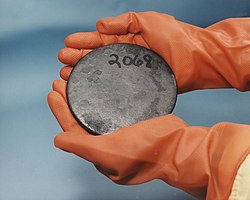From Wikipedia, the free encyclopedia
| Uranium-235 | |
|---|---|
 Uranium metal highly enriched in uranium-235 |
|
| General | |
| Name, symbol | Uranium-235,235U |
| Neutrons | 143 |
| Protons | 92 |
| Nuclide data | |
| Natural abundance | 0.72% |
| Half-life | 703,800,000 years |
| Parent isotopes | 235Pa 235Np 239Pu |
| Decay products | 231Th |
| Isotope mass | 235.0439299 u |
| Spin | 7/2− |
| Excess energy | 40914.062 ± 1.970 keV |
| Binding energy | 1783870.285 ± 1.996 keV |
| Decay mode | Decay energy |
| Alpha | 4.679 MeV |
Uranium-235 has a half-life of 703.8 million years. It was discovered in 1935 by Arthur Jeffrey Dempster. Its (fission) nuclear cross section for slow thermal neutrons is about 584.994 barns. For fast neutrons it is on the order of 1 barn.[1] Most but not all neutron absorptions result in fission; a minority result in neutron capture forming uranium-236.
Fission
The fission of one atom of U-235 generates 202.5 MeV = 3.24 × 10−11 J, which translates to 19.54 TJ/mol, or 83.14 TJ/kg.[2] When 235
92U nuclides are bombarded with neutrons, one of the many fission reactions that it can undergo is the following (shown visually in the image to the left):
0n + 235
92U → 141
56Ba + 92
36Kr + 3 1
0n
Heavy water reactors, and some graphite moderated reactors can use unenriched uranium, but light water reactors must use low enriched uranium because of light water's neutron absorption. Uranium enrichment removes some of the uranium-238 and increases the proportion of uranium-235. Highly enriched uranium, which contains an even greater proportion of U-235, is sometimes used in nuclear weapon design.
If at least one neutron from U-235 fission strikes another nucleus and causes it to fission, then the chain reaction will continue. If the reaction will sustain itself, it is said to be critical, and the mass of U-235 required to produce the critical condition is said to be a critical mass. A critical chain reaction can be achieved at low concentrations of U-235 if the neutrons from fission are moderated to lower their speed, since the probability for fission with slow neutrons is greater. A fission chain reaction produces intermediate mass fragments which are highly radioactive and produce further energy by their radioactive decay. Some of them produce neutrons, called delayed neutrons, which contribute to the fission chain reaction. In nuclear reactors, the reaction is slowed down by the addition of control rods which are made of elements such as boron, cadmium, and hafnium which can absorb a large number of neutrons. In nuclear bombs, the reaction is uncontrolled and the large amount of energy released creates a nuclear explosion.
Nuclear weapons
The Little Boy gun type atomic bomb dropped on Hiroshima on August 6, 1945 was made of highly enriched uranium with a large tamper. The nominal spherical critical mass for an untampered 235U nuclear weapon is 56 kilograms (123 lb),[3] a sphere 17.32 cm (6.8") in diameter. The required material must be 85% or more of 235U and is known as weapons grade uranium, though for a crude, inefficient weapon 20% is sufficient (called weapon(s)-usable). Even lower enrichment can be used, but then the required critical mass rapidly increases. Use of a large tamper, implosion geometries, trigger tubes, polonium triggers, tritium enhancement, and neutron reflectors can enable a more compact, economical weapon using one-fourth or less of the nominal critical mass, though this would likely only be possible in a country that already had extensive experience in engineering nuclear weapons. Most modern nuclear weapon designs use plutonium as the fissile component of the primary stage,[4][5] however HEU is often used in the secondary stage.| Source | Average energy released [MeV][2] |
|---|---|
| Instantaneously released energy | |
| Kinetic energy of fission fragments | 169.1 |
| Kinetic energy of prompt neutrons | 4.8 |
| Energy carried by prompt γ-rays | 7.0 |
| Energy from decaying fission products | |
| Energy of β−-particles | 6.5 |
| Energy of delayed γ-rays | 6.3 |
| Energy released when those prompt neutrons which don't (re)produce fission are captured | 8.8 |
| Total energy converted into heat in an operating thermal nuclear reactor | 202.5 |
| Energy of anti-neutrinos | 8.8 |
| Sum | 211.3 |
- A piece of U-235 (uranium-235, a rare form of uranium) the size of a grain of rice can produce energy equal to that contained in three tons of coal or fourteen barrels of oil. (Contemporary's Science)[full citation needed]

